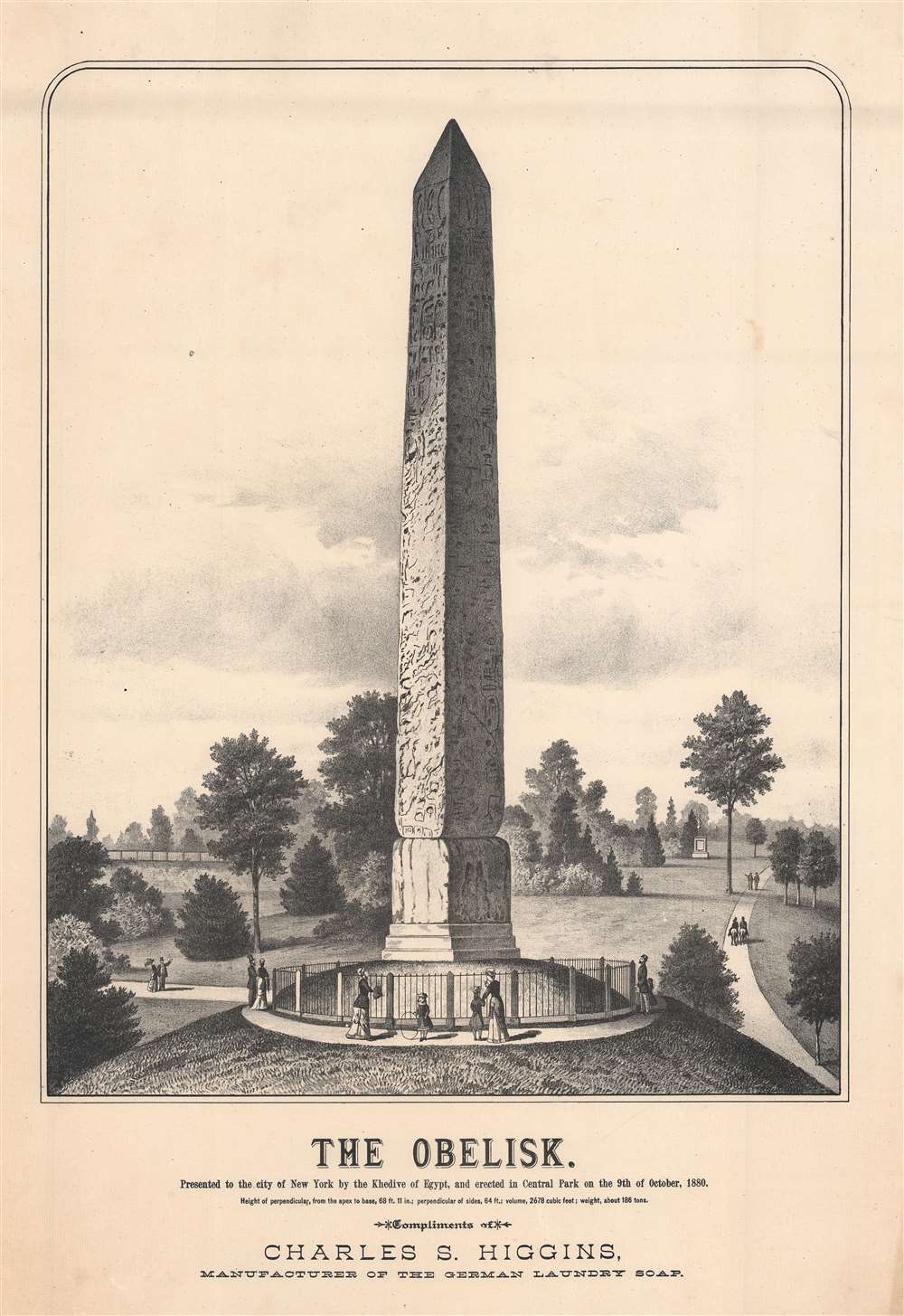1880 Higgins Lithograph View of the Obelisk (Cleopatra's Needle), Central Park, New York City
TheObelisk-higgins-1880$850.00

Title
The Obelisk. Presented to the city of New York by the Khedive of Egypt, and erected in Central Park on the 9th of October, 1880.
1880 (undated) 21.5 x 14.25 in (54.61 x 36.195 cm)
1880 (undated) 21.5 x 14.25 in (54.61 x 36.195 cm)
Description
This is a c. 1880 Charles S. Higgins view of The Obelisk, also known as Cleopatra's Needle, located on Greywacke Knoll in Central Park, New York City. Fashionable New Yorkers surround and admire New York's oldest artwork. Central Park's trees and paths appear in the background.
The obelisk was originally carved and erected in 1475 BC by order of Pharoah Thutmose III. It is one of a pair that stood at the entrance to the Temple of the Sun at Heliopolis. It remained there for 1,500 years, although for 500 years, it and its sister lay toppled in the sand. The Romans discovered the toppled obelisks and moved them to Alexandria, where they stood in front of the Caesareum, a temple built by Cleopatra and dedicated to Julius Caesar (or maybe Mark Antony?). Perhaps this is why the obelisks were called Cleopatra's Needles.
Fast forward to 1877 when one obelisk was gifted to London and the other to New York City. The 200-ton obelisk left Egypt on June 12, 1880, aboard the SS Dessoug. A hole had to be cut in the side of the ship to load it! The hole was recut after the Dessoug arrived in New York 112 days later. It took four months for the obelisk to make its way across New York City to its final resting place in Central Park. The obelisk was erected in January 1881. The October 9, 1880, date referred to here was when the cornerstone of the pedestal on which the obelisk stands was laid. The obelisk's formal dedication took place at the Metropolitan Museum of Art on February 22, 1881. Although still in Central Park, Cleopatra's Needle was never intended for the wet, cold New York environment or modern pollution and acid rain. Its delicate hieroglyphic carvings have fared poorly despite the granite's indomitability. For more information, please reference The New York Obelisk or How Cleopatra's Needle Came to New York and What Happened When It Got Here, edited by Martina D'Alton from Henry Honychurch Gorringe's original account.
The Obelisk, or Cleopatra's Needle
The Obelisk, as it is known by the Central Park Conservancy, or Cleopatra's Needle, as it is known by pretty much everyone else in New York City, arrived in New York in 1880 as a gift from the Khedive of Egypt, Isma'il Pasha. Isma'il Pasha's motivations were unclear, but the gift is believed to have been in recognition of the U.S. neutrality when Britain and France were actively pressuring concessions from the Egyptian government.The obelisk was originally carved and erected in 1475 BC by order of Pharoah Thutmose III. It is one of a pair that stood at the entrance to the Temple of the Sun at Heliopolis. It remained there for 1,500 years, although for 500 years, it and its sister lay toppled in the sand. The Romans discovered the toppled obelisks and moved them to Alexandria, where they stood in front of the Caesareum, a temple built by Cleopatra and dedicated to Julius Caesar (or maybe Mark Antony?). Perhaps this is why the obelisks were called Cleopatra's Needles.
Fast forward to 1877 when one obelisk was gifted to London and the other to New York City. The 200-ton obelisk left Egypt on June 12, 1880, aboard the SS Dessoug. A hole had to be cut in the side of the ship to load it! The hole was recut after the Dessoug arrived in New York 112 days later. It took four months for the obelisk to make its way across New York City to its final resting place in Central Park. The obelisk was erected in January 1881. The October 9, 1880, date referred to here was when the cornerstone of the pedestal on which the obelisk stands was laid. The obelisk's formal dedication took place at the Metropolitan Museum of Art on February 22, 1881. Although still in Central Park, Cleopatra's Needle was never intended for the wet, cold New York environment or modern pollution and acid rain. Its delicate hieroglyphic carvings have fared poorly despite the granite's indomitability. For more information, please reference The New York Obelisk or How Cleopatra's Needle Came to New York and What Happened When It Got Here, edited by Martina D'Alton from Henry Honychurch Gorringe's original account.
The Charles S. Higgins Company
The Charles S. Higgins Company, based in Brooklyn, New York, manufactured soap during the second half of the nineteenth century. Charles S. Higgins' father founded the company in 1846, and Charles S. Higgins took over following his father's 1860 death.Publication History and Census
This view was published compliments of Charles S. Higgins c. 1880. We note two cataloged examples: one at the Metropolitan Museum of Art and the other at the New-York Historical Society. The present example is not signed by an artist and does not bear an imprint. However, the example in the collection at the Metropolitan Museum of Art was printed by W. H. Forbes and Company and published by Higgins, suggesting that the present example was likely also printed by Forbes. We note only one other instance of this broadside appearing on the private market.Condition
Very good.
References
New-York Historical Society PR.020.FF.9. Metropolitan Museum of Art 68.702.

